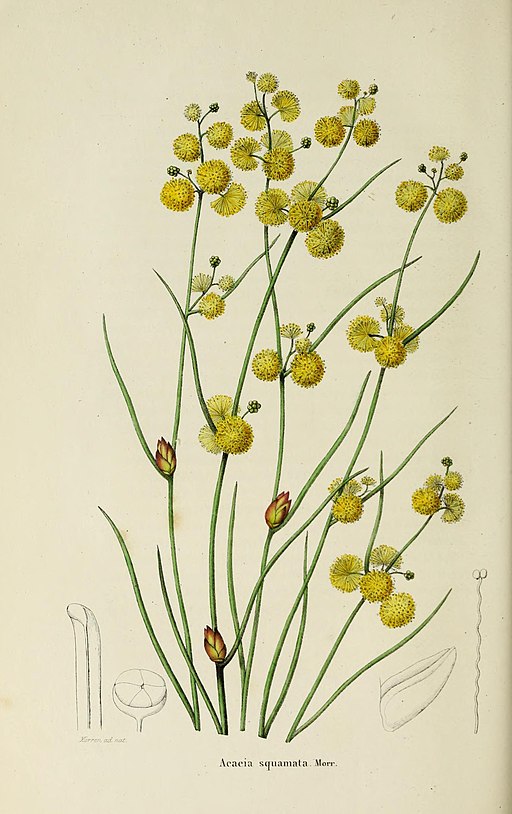Classification System: APG IV
Superregnum: Eukaryota
Regnum: Plantae
Cladus: Angiosperms
Cladus: Eudicots
Cladus: Core eudicots
Cladus: Rosids
Cladus: Eurosids I
Ordo: Fabales
Familia: Fabaceae
Subfamilia: Caesalpinioideae
Tribus: Acacieae
Genus: Acacia
Species: Acacia squamata
Name
Acacia squamata Lindl., 1839
Synonyms
Racosperma squamatum (Lindl.) Pedley
Homonyms
Acacia squamata C.Morren = Acacia restiacea Benth.
Distribution
Native distribution areas:
Acacia squamata
Continental: Australasia
Regional: Australia
Western Australia
References: Brummitt, R.K. 2001. TDWG – World Geographical Scheme for Recording Plant Distributions, 2nd Edition
References
Primary references
Lindley, J. 1839-1840. Appendix to the first twenty-three volumes of Edwards's botanical register consisting of a complete alphabetical and systematical index of names, synomymes and matter, adjusted to the present state of systematical botany, together with a sketch of the vegetation of the Swan River colony. iv + lviii + lxiv p., 9 pl. London: James Ridgway. BHL Reference page. : xv.
Links
Govaerts, R. et al. 2020. Acacia squamata in Kew Science Plants of the World online. The Board of Trustees of the Royal Botanic Gardens, Kew. Published on the internet. Accessed: 2020 Aug 15. Reference page.
International Plant Names Index. 2019. Acacia squamata. Published online. Accessed: Aug 15 2019.
Tropicos.org 2019. Acacia squamata. Missouri Botanical Garden. Published on the internet. Accessed: 2019 Aug 15.
Catalogue of Life: 2021 Annual Checklist
Acacia squamata – Taxon details on World Wide Wattle.
USDA, ARS, Germplasm Resources Information Network. Acacia squamata in the Germplasm Resources Information Network (GRIN), U.S. Department of Agriculture Agricultural Research Service. Accessed: 09-Oct-10.
Vernacular names
Acacia squamata is a shrub of the genus Acacia and the subgenus Phyllodineae that is endemic to south western Australia.
Description
The erect and sometimes trailing shrub typically grows to a height of 0.1 to 0.6 metres (0.3 to 2.0 ft).[1] It is usually has maulitple glabrous stems and is occasionally rhizomatous. The flexible, green to grey green cylindrical stems have barely visible nerves. Like most species of Acacia it has phyllodes rather than true leaves. The distant grey-green phyllodes resemble the stems and are ascending to erect with a length of 2 to 7 cm (0.79 to 2.76 in) and a width of 1 to 2 mm (0.039 to 0.079 in) and sometimes have a hooked appearance.[2] It blooms from July to September and produces yellow flowers.[1] The simple inflorescences occur in pairs of groups of four an short racemes. The spherical flower-heads contain 6 to 11 golden coloured flowers. Following flowering crustaceous seed pods form that have a linear to narrowly oblong shape with a length of up to 8 cm (3.1 in) and a width of 4 to 5 mm (0.16 to 0.20 in) with thickened margins. The dull to shiny brown seeds inside are arranged longitudinally and have an oblong shape with a length of about 4 mm (0.16 in).[2]
Taxonomy
The type specimen was collected by James Drummond in 1839.[2]
Description
It is native to an area in the Wheatbelt, Great Southern and South West regions of Western Australia where it mostly grows in gravelly lateritic soils.[1] The bulk of the population is found from around Bindoon in the north west down to around Mount Barker extending to around Fitzgerald River National Park in the south east and up to around Newdegate in the north east growing in a variety of habitats in sandy to loamy laterite based soils as a part of Eucalyptus woodland, heath or scrubland communities.[2]
See also
List of Acacia species
References
"Acacia squamata". FloraBase. Western Australian Government Department of Biodiversity, Conservation and Attractions.
"Acacia squamata". WorldWideWorld. Western Australian Herbarium. Retrieved 28 April 2020.
Retrieved from "http://en.wikipedia.org/"
All text is available under the terms of the GNU Free Documentation License


